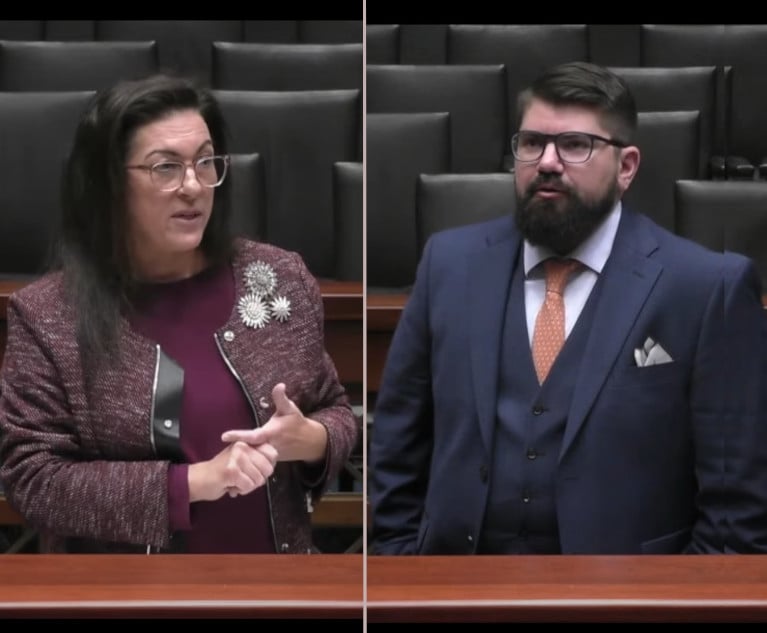Law Schools Shift Strategy to Attract Top Students—Money
Once the 2008 Great Recession starting hitting law schools where it counts—student enrollment—they had to utilize new methods to attract top students.Money did it.
March 28, 2019 at 06:00 AM
7 minute read

Once the 2008 Great Recession starting hitting law schools where it counts—student enrollment—they had to utilize new methods to attract top students.
Money did it.
Data from the nation's law school accrediting body shows that between 2011 and 2018, the majority of Texas law schools increased both the percentage of their students who won a grant or scholarship and simultaneously doled out larger amounts of money when they did give. For example, Texas A&M University School of Law (formerly Texas Wesleyan University School of Law) used to give grants to just 35 percent of its students in 2011, but upped the rate to 81 percent in 2018. Meanwhile, St. Mary's University School of Law raised its median grant amount by a whopping 398 percent, from $2,000 to $10,000 between 2011 and 2018.
What can explain such generosity? Nationwide data may shed light on why schools were willing to shell out so much.
The recession spurred a phenomenon of fewer applicants applying to law school, and those who did tended to have lower Law School Admissions Test scores than in previous years. For example, in 2007 there were nearly 22,200 students with LSAT scores higher than 160, but in 2016, the same high-scoring group counted just 14,500 students, according to U.S. News & World Report. Law schools coveted the smaller pool of high-scorers, which meant students had a better chance of winning scholarships that were likely to be more generous than in the past. Aside from the scholarship game, another strategy to nab students was to discount tuition, with discounts increasing from 33 percent to 38 percent from 2015 to 2016. In the latter year, nearly half of law students benefited from discounting, reported U.S. News.
Lady luck smiled on Texas law students, by the looks of data from the American Bar Association Section of Legal Education and Admissions to the Bar. Texas Lawyer scoured the data that the Lone Star State's 10 law schools submitted to the ABA in 2011, the first year data was available, and 2018 to see how many more students received scholarships, and how much those scholarship amounts increased.
Higher percentages of students won scholarships
The percentage of students who won a scholarship or grant rose from 56 percent in 2011 to 67 percent in 2018.
We ranked the Texas law schools based on how steeply they increased their grant recipient rates. Here's the layout:
1. Texas A&M University School of Law increased its rate from 35 percent to 81 percent, a 46-point climb.
2. St. Mary's University School of Law increased from 36 percent to 59 percent, a 23-point climb.
3. Southern Methodist University Dedman School of Law went from 66 percent to 84 percent, an 18-point increase.
4. There was also an 18-point increase at the University of Houston Law Center, which went from 57 percent to 75 percent. We're ranking it No. 4 because it ended up at a lower percentage of students winning grants than at SMU Dedman School of Law.
5. South Texas College of Law Houston increased its rate from 36 percent to 46 percent, a 10-point climb.
6. Texas Tech University School of Law increased its rate from 64 percent to 72 percent, an 8-point climb.
7. The University of Texas School of Law increased its rate from 87 percent to 90 percent, a 3-point raise.
8. There was also a 3-point increase at Baylor University School of Law, which increased its rate from 74 percent to 77 percent. We're ranking it No. 8 since it wound up at a lower percentage than Texas.
9. Texas Southern University Thurgood Marshall School of Law was the only law school to decrease its scholarship recipient rate, going from 52 percent to 51 percent, a 1-point drop.
Unranked — The University of North Texas Dallas College of Law reported in 2018 that 52 percent of students received grants. We couldn't compare 2011 to 2018 because the school opened in 2015 and gained provisional accreditation in 2017.
Students received more money
Just as the rates of grant winners were rising, so were the amounts students won. In 2011, the median grant amount ranged from $2,000 to $22,000, depending on the school, and the average statewide amount was $8,900. The statewide average rose to $13,200 by 2018, with median grant amounts ranging from $1,500 to $32,000.
Here's how the Texas law schools measured up when it came to trends in median grant amounts from 2011 to 2018. We listed the schools based on the rate at which they increased their median grant amounts, which we rounded to the nearest hundred. Using each school's 2018 tuition and fees, and subtracting its median grant amount, we estimated how much a student might pay. Keep in mind, some schools offer additional discounts—these aren't listed in ABA data.
1. St. Mary's University School of Law increased its median grant amount by 398 percent, from $2,000 to $10,000. In 2018 its annual tuition was $37,400, which means a student winning the median grant amount would pay $27,400.
2. University of Houston Law Center saw a 355 percent increase, from $2,200 to $10,000. With a 2018 tuition of $32,100, a student with a median grant would pay $22,100.
3. Texas A&M saw a 153 percent grant amount increase, from $7,500 to $18,900. The 2018 tuition was $31,000, so a student with a median grant would pay $12,100.
4. Texas Tech University School of Law saw an 86 percent increase, from $5,400 to $10,000. Its 2018 tuition was $26,800, so a person with a median grant would pay $16,800.
5. University of Texas Law School saw a 71 percent increase, from $8,500 to $14,500. With 2018 tuition set at $35,700, a student with a median grant would pay $21,200.
6. South Texas College of Law saw a 61 percent increase, from $4,200 to $6,800. Tuition was $32,400 in 2018, meaning a student with a median grant would pay $25,600.
7. Baylor Law School saw a 44 percent increase, from $22,200 to $32,000. Its 2018 tuition was $62,400, meaning someone with a median grant would pay $30,400.
8. Texas Southern reported that its median grant amount in 2011 was $8,200, which rose to $10,000 in 2018, a 22 percent increase. Its 2018 tuition was $20,400, meaning a winner of a median grant amount would pay $10,400.
9. SMU Dedman School of Law was the only school to decrease its median grant amount, from $20,200 to $18,000, an 11 percent decrease. Tuition was $54,100 in 2018, meaning a student with a median grant would pay $36,100.
Unranked — We couldn't compare 2011 to 2018 median grant amounts at UNT Dallas College of Law because the school just opened in 2015 and gained provisional accreditation in 2017. However, it's 2018 ABA report said its median grant amount is $1,500. Tuition in 2018 was $18,200, which means someone with a median grant would pay $16,700.
Angela Morris is an Austin-based freelance journalist. Follow her on Twitter at @AMorrisReports.
This content has been archived. It is available through our partners, LexisNexis® and Bloomberg Law.
To view this content, please continue to their sites.
Not a Lexis Subscriber?
Subscribe Now
Not a Bloomberg Law Subscriber?
Subscribe Now
NOT FOR REPRINT
© 2025 ALM Global, LLC, All Rights Reserved. Request academic re-use from www.copyright.com. All other uses, submit a request to [email protected]. For more information visit Asset & Logo Licensing.
You Might Like
View All
'It's Like They Lynched You:' Law Professor's Discrimination Claim Reaches High Court
7 minute read


Trending Stories
Who Got The Work
J. Brugh Lower of Gibbons has entered an appearance for industrial equipment supplier Devco Corporation in a pending trademark infringement lawsuit. The suit, accusing the defendant of selling knock-off Graco products, was filed Dec. 18 in New Jersey District Court by Rivkin Radler on behalf of Graco Inc. and Graco Minnesota. The case, assigned to U.S. District Judge Zahid N. Quraishi, is 3:24-cv-11294, Graco Inc. et al v. Devco Corporation.
Who Got The Work
Rebecca Maller-Stein and Kent A. Yalowitz of Arnold & Porter Kaye Scholer have entered their appearances for Hanaco Venture Capital and its executives, Lior Prosor and David Frankel, in a pending securities lawsuit. The action, filed on Dec. 24 in New York Southern District Court by Zell, Aron & Co. on behalf of Goldeneye Advisors, accuses the defendants of negligently and fraudulently managing the plaintiff's $1 million investment. The case, assigned to U.S. District Judge Vernon S. Broderick, is 1:24-cv-09918, Goldeneye Advisors, LLC v. Hanaco Venture Capital, Ltd. et al.
Who Got The Work
Attorneys from A&O Shearman has stepped in as defense counsel for Toronto-Dominion Bank and other defendants in a pending securities class action. The suit, filed Dec. 11 in New York Southern District Court by Bleichmar Fonti & Auld, accuses the defendants of concealing the bank's 'pervasive' deficiencies in regards to its compliance with the Bank Secrecy Act and the quality of its anti-money laundering controls. The case, assigned to U.S. District Judge Arun Subramanian, is 1:24-cv-09445, Gonzalez v. The Toronto-Dominion Bank et al.
Who Got The Work
Crown Castle International, a Pennsylvania company providing shared communications infrastructure, has turned to Luke D. Wolf of Gordon Rees Scully Mansukhani to fend off a pending breach-of-contract lawsuit. The court action, filed Nov. 25 in Michigan Eastern District Court by Hooper Hathaway PC on behalf of The Town Residences LLC, accuses Crown Castle of failing to transfer approximately $30,000 in utility payments from T-Mobile in breach of a roof-top lease and assignment agreement. The case, assigned to U.S. District Judge Susan K. Declercq, is 2:24-cv-13131, The Town Residences LLC v. T-Mobile US, Inc. et al.
Who Got The Work
Wilfred P. Coronato and Daniel M. Schwartz of McCarter & English have stepped in as defense counsel to Electrolux Home Products Inc. in a pending product liability lawsuit. The court action, filed Nov. 26 in New York Eastern District Court by Poulos Lopiccolo PC and Nagel Rice LLP on behalf of David Stern, alleges that the defendant's refrigerators’ drawers and shelving repeatedly break and fall apart within months after purchase. The case, assigned to U.S. District Judge Joan M. Azrack, is 2:24-cv-08204, Stern v. Electrolux Home Products, Inc.
Featured Firms
Law Offices of Gary Martin Hays & Associates, P.C.
(470) 294-1674
Law Offices of Mark E. Salomone
(857) 444-6468
Smith & Hassler
(713) 739-1250






